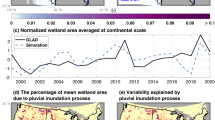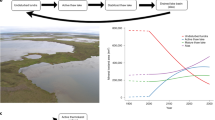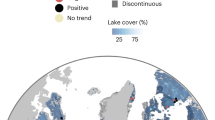Abstract
Wetlands are vegetated regions that are inundated with water on a permanent, seasonal or intermittent basis1. These ecosystems play an important role in the carbon cycle: wetlands take up and store carbon, and release carbon dioxide and methane through the decomposition of organic matter2. More than 50% of wetlands are located in the high northern latitudes3, where permafrost also prevails and exerts a strong control on wetland hydrology4. Permafrost degradation is linked to changes in Arctic lakes: between 1973 and 2004 the abundance of lakes increased in continuous permafrost zones, but decreased in other zones5. Here, we use a global climate model to examine the influence of permafrost thaw on the prevalence of high-latitude northern wetlands, under four emissions scenarios. We show that as permafrost degrades, the areal extent of wetlands declines; we found a net loss in wetland extent in the three highest emissions scenarios. We also note an initial increase in the number of days of the year conducive to wetland formation, owing to an increase in unfrozen surface moisture resulting from a lengthening of the thaw season. This is followed by a dramatic decline in the number of wetland-conducive days, owing to a deepening of the permafrost surface, and drainage of near-surface moisture to deeper soil layers. We suggest that a reduction in the areal extent and duration of wetlands will influence high-latitude carbon emissions.
This is a preview of subscription content, access via your institution
Access options
Subscribe to this journal
Receive 12 print issues and online access
$259.00 per year
only $21.58 per issue
Buy this article
- Purchase on Springer Link
- Instant access to full article PDF
Prices may be subject to local taxes which are calculated during checkout




Similar content being viewed by others
References
Wheeler, B. D. in Eco-hydrology: Plants and Water in Terrestrial and Aquatic Environments (eds Baird, A. J. & Wilby, R. L.) 127–180 (Routledge, 1999).
Mitra, S., Wassman, R. & Vlek, P. Global Inventory of Wetlands and Their Role in the Carbon Cycle, ZEF—Discussion Papers on Development Policy No. 64 (Center for Development Research, 2003).
Wania, R. Modelling Northern Peatland Surface Processes, Vegetation Dynamics and Methane Emissions PhD dissertation, Univ. Bristol (2007).
Woo, M-K. & Winter, T. C. The role of permafrost and seasonal frost in the hydrology of northern wetlands in North America. J. Hydrol. 141, 5–31 (1993).
Smith, L. C., Sheng, Y., MacDonald, G. M. & Hinzman, L. D. Disappearing Arctic lakes. Science 308, 1429 (2005).
Weaver, A. J. et al. The UVic Earth System Climate Model: Model description, climatology and applications to past, present and future climates. Atmos. Ocean 39, 361–428 (2001).
Meissner, K. J., Weaver, A. J., Matthews, H. D. & Cox, P. M The role of land-surface dynamics in glacial inception: A study with the UVic Earth System Climate Model. Clim. Dyn. 21, 515–537 (2003).
Zhang, T., Heginbottom, J. A., Barry, R. G. & Brown, J. Further statistics on the distribution of permafrost and ground ice in the Northern Hemisphere. Pol. Geogr. 24, 126–131 (2000).
Brown, J., Hinkel, K. M. & Nelson, F. E. The Circumpolar Active Layer Monitoring (CALM) program: Research designs and initial results. Pol. Geogr. 24, 166–258 (2000).
Moss, R. H. et al. The next generation of scenarios for climate change research and assessment. Nature 463, 747–756 (2010).
RCP Database Version 2.0.4, http://www.iiasa.ac.at/web-apps/tnt/RcpDb/ (2009).
Lawrence, D. M. et al. Sensitivity of a model projection of near-surface permafrost degradation to soil column depth and representation of soil organic matter. J. Geophys. Res. 113, F02011 (2008).
Saito, K. et al. Evaluating a high-resolution climate model: Simulated hydrothermal regimes in frozen ground regions and their change under the global warming scenario. J. Geophys. Res. 112, F02S11 (2007).
Demchenko, P. et al. Sensitivity of permafrost cover in the Northern Hemisphere to climate change. Clivar Exch. 6, 9–11 (2001).
Kaplan, J. Wetlands at the Last Glacial Maximum: Distribution and methane emissions. Geophys. Res. Lett. 29, 1079 (2002).
Shindell, D., Walter, B. P. & Faluvegi, G. Impacts of climate change on methane emissions from wetlands. Geophys. Res. Lett. 31, L21202 (2004).
Weber, S. L., Drury, A. J., Toonen, W. H. J. & van Weele, M. Wetland methane emissions during the Last Glacial Maximum estimated from PMIP2 simulations: Climate, vegetation and geographic controls. J. Geophys. Res. 115, D06111 (2010).
Lehner, B. & Döll, P. Development and validation of a global database of lakes, reservoirs and wetlands. J. Hydrol. 296, 1–22 (2004).
Matthews, E. & Fung, I. Methane emissions from natural wetlands: Global distribution, area and environmental characteristics of sources. Glob. Biogeochem. Cycles 1, 61–86 (1987).
Finalyson, C. M. et al. in Ecosystems and Human Well-Being: Current State and Trends (eds Hassan, H., Scholes, R. & Ash, N.) 551–583 (Island, 2005).
Frolking, et al. in Carbon Cycling in Northern Peatlands (eds Baird, A. J., Belyea, L. R., Comas, X., Reeve, A. S. & Slater, L. D.) 19–26 (AGU, 2009).
Smith, L. C., Sheng, Y & MacDonald, G. M. A first pan-Arctic assessment of the influence of glaciation, permafrost, topography and peatlands on Northern Hemisphere lake distribution. Permafrost Periglac 18, 201–208 (2007).
Denman, K. L. et al. in IPCC Climate Change 2007: The Physical Science Basis (eds Solomon, S. et al.) 499–587 (Cambridge Univ. Press, 2007).
Tarnocai, C. et al. Soil organic carbon pools in the northern circumpolar permafrost region. Glob. Biogeochem. Cycles 23, GB2023 (2009).
Forster, P. et al. in Climate Change 2007: The Physical Science Basis (eds Solomon, S. et al.) 129–234 (Cambridge Univ. Press, 2007).
Cox, P. M. et al. The impact of new land surface physics on the GCM simulation of climate and climate sensitivity. Clim. Dyn. 15, 183–203 (1999).
Global Soil Data Task Group, Global gridded surfaces of selected soil characteristics (IGBP-DIS), http://www.daac.ornl.gov/ (2000).
Lawrence, D. M. & Slater, A. G. Incorporating organic soil into a global climate model. Clim. Dyn. 30, 145–160 (2008).
Petoukhov, V. et al. EMIC intercomparison project (EMIP-CO2): Comparative analysis of EMIC simulations of climate and of equilibrium and transient responses to atmospheric CO2 doubling. Clim. Dyn. 25, 363–385 (2005).
US Department of Commerce, National Oceanic and Atmospheric Administration, National Geophysical Data Center, 2-minute Gridded Global Data Relief (ETOPO2v2), http://www.ngdc.noaa.gov/mgg/fliers/06mgg01.html (2006).
Acknowledgements
The authors wish to acknowledge the assistance of V. Arora, M. Eby, K. Zickfeld, E. Wiebe and R. Wania. We are grateful to the National Science and Engineering Research Council of Canada, the Canadian Foundation for Climate and Atmospheric Sciences and the Australian Research Council for providing research support.
Author information
Authors and Affiliations
Contributions
C.A.A., A.J.W. and K.J.M. formulated the model experiments and wrote the paper. C.A.A. performed modifications to the ESCM, conducted the experiments and analysed the results.
Corresponding author
Ethics declarations
Competing interests
The authors declare no competing financial interests.
Supplementary information
Supplementary Information
Supplementary Information (PDF 957 kb)
Rights and permissions
About this article
Cite this article
Avis, C., Weaver, A. & Meissner, K. Reduction in areal extent of high-latitude wetlands in response to permafrost thaw. Nature Geosci 4, 444–448 (2011). https://doi.org/10.1038/ngeo1160
Received:
Accepted:
Published:
Issue Date:
DOI: https://doi.org/10.1038/ngeo1160
This article is cited by
-
Delaying methane mitigation increases the risk of breaching the 2 °C warming limit
Communications Earth & Environment (2023)
-
Weakening greenhouse gas sink of pristine wetlands under warming
Nature Climate Change (2023)
-
Impact of historical pattern of human activities and natural environment on wetland in Heilongjiang River Basin
Frontiers of Environmental Science & Engineering (2023)
-
Wetlands Insight Tool: Characterising the Surface Water and Vegetation Cover Dynamics of Individual Wetlands Using Multidecadal Landsat Satellite Data
Wetlands (2023)
-
Ecological integrity and conservation challenges in a rapidly changing Arctic: A call for new approaches in large intact landscapes
Ambio (2022)



